PAUL RUTTKAY, Burroughs Corp.
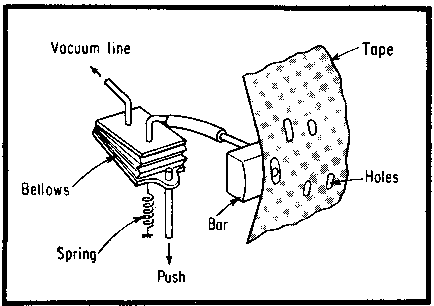
|
1.
An old method of reading punched tape pneumatically, used widely in
the player piano. Tapes are wide, of coarse pitch. The technique
is simple, rugged, not very fast. When a hole in the tape opens
the port in the metal bar, atmospheric pressure allows the spring to
expand the bellows to give a direct mechanical push.
|
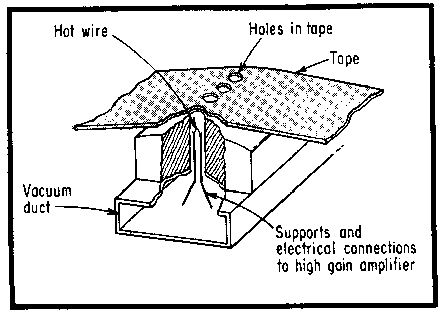
|
2.
The hot wire anemometer technique is the newest way being used
to read punched tape. A small wire, about 0.0005 inch diameter
by about 1/16th inch long, is supported in a duct and heated by
current. When hole in tape opens, air flow changes wire temperature,
hence resistance, providing a low-level electrical signal. Capable
of very high reading rates.
|

|
3.
A conventional method of reading stepped tape.
The tape is supported by a block with a hole for
each channel. While the tape is in motion, bail
holds contact levels up. When tape stops, fingers
rest on tape. Where there is a hole, finger enters
it, making electrical contact. This design has many
variations, such as offset fingers for more contact
room, double-contact blades for isolated channels,
etc. Contact blade spring period can be critical.
Cost moderate. Speed about 5 pitches per second.
Tape about 1 inch wide, 8 channels plus spocket on
1/10th inch centers; other sizes can be used.
|
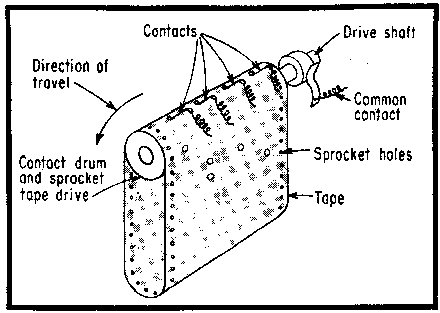
|
4.
A conventional method of reading program tape.
Tape can travel one direction only - reversal will damage contacts.
A wide variety of contacts readily available from stock. Maximum
speeds with stepped tape motion about 40 steps per second; with
continuous tape motion, as high as 60 inches per second. Contact
life several million cycles. As many as 50 channels can be placed on
a 3-inch wide tape, each channel controlling one circuit. Sprocket
pitch about 1/10 inch. Although contacts can operate small current
relays, electronic equipment may be better. Mechanical cost moderate,
electronic cost can vary.
|
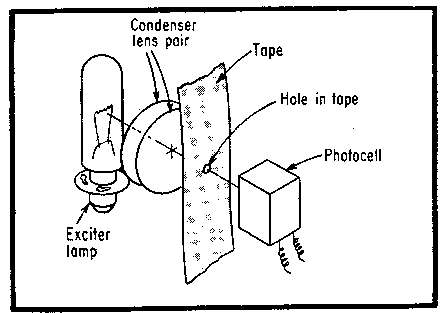
|
5.
The basic technique for reading punched tape photoelectrically.
Fast, reliable, quiet, with no moving parts. May be used with
stepped or continuously moving tape. Uses one photoelectric
cell or photomultiplier tube for each channel. Prisms, mirrors,
light pipes, lenses, etc., used to spread light beams from
channels to obtain room for photocells. Cost intermediate.
|
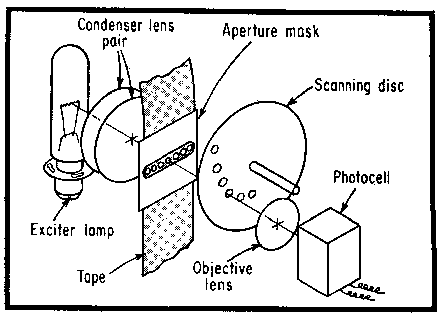
|
6.
Photoelectric system using one photocell and a mechanically driven
scanning disc to give a serial output from the tape. The scanning
disc replaces electronic equipment otherwise required to obtain
serial output for single line transmission of the tape information.
|
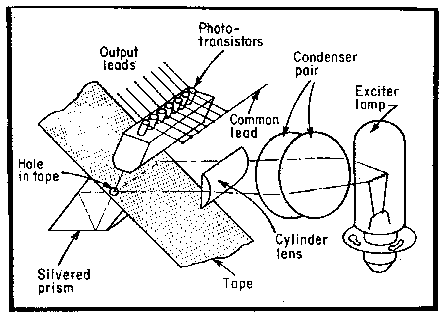
|
7.
A silvered prism behind the punched tape reflects light from the
exciter lamp back out through the same hole, to fall normally on
the phototransistors. This same arrangement will also read opaque
tape with printed dots by reflected light (the prism being
inoperative). Approximately the same ranges and limitations on
reading speeds and channel spacing as in the more common
arrangement in Figure 8.
|
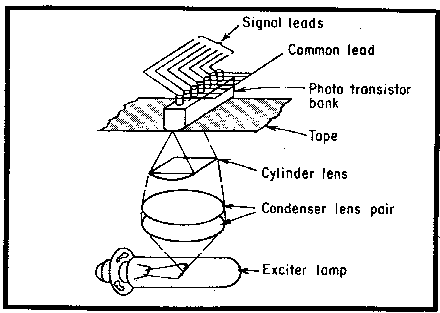
|
8.
An optional method for high-speed reading of 6, 7 or 8 channels
(plus sprocket) using small phototransistors (about 0.080 inch
diameter by 9/16 inch long) mounted in phenolic block directly over
the center of the 1/10th inch spaced information channels. Reading
speeds from about 7 to 1,000 characters per second, depending on
tape drive mechanism. (Present phototransistors have a maximum
limit of about 10 kc). Cost relatively expensive.
|

